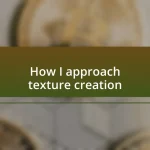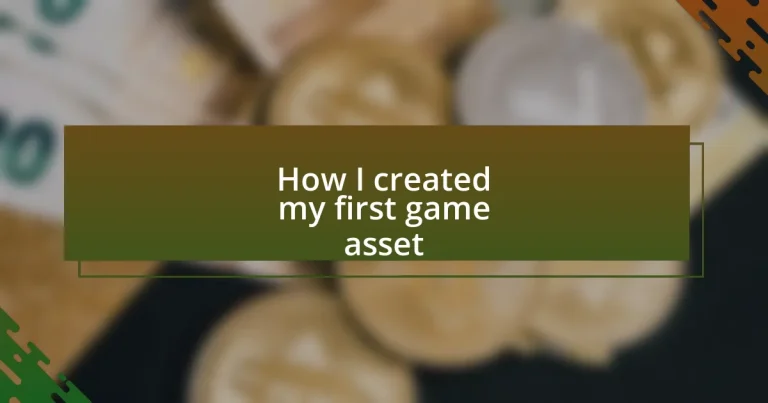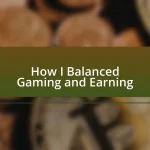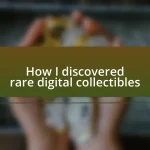Key takeaways:
- Game assets, including both 2D and 3D, are essential for gameplay and storytelling, requiring understanding of their emotional impact and technical formats.
- Choosing the right software is crucial, balancing usability with the project’s needs; familiar programs can enhance creativity and efficiency.
- Iterative testing and feedback are vital for refining game assets, leading to better integration and player experience.
- Optimizing assets for performance involves factors like polygon count and texture resolution, significantly affecting gameplay smoothness and visual appeal.
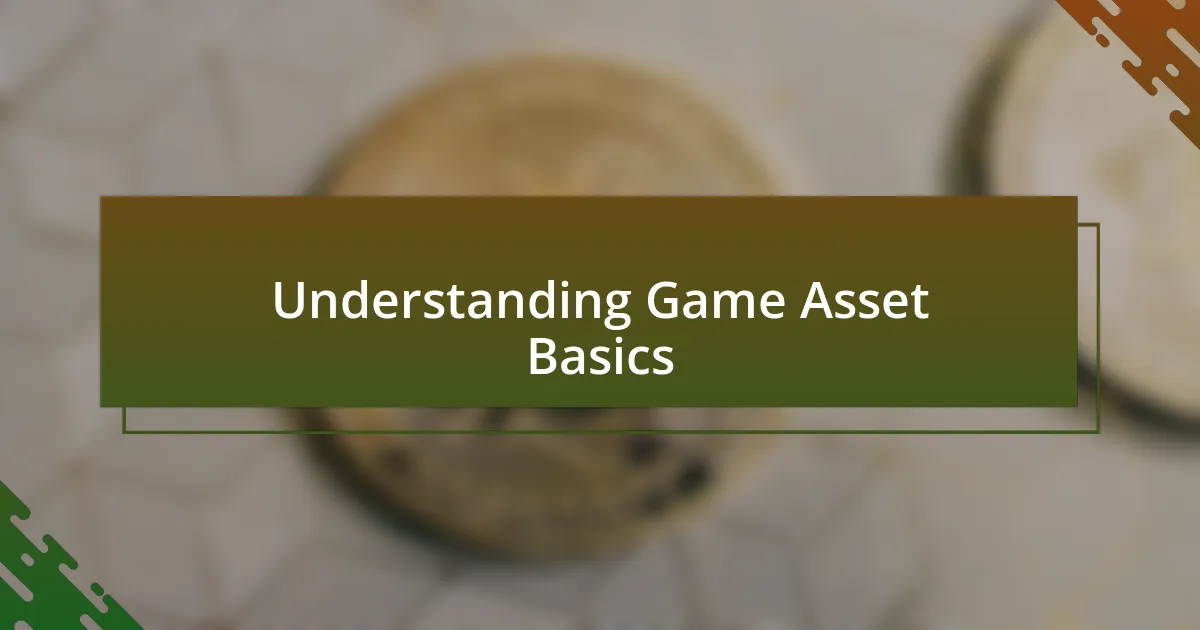
Understanding Game Asset Basics
Game assets are the building blocks of any game, capturing everything from characters to environments. When I first ventured into game development, I felt overwhelmed by the sheer variety of assets I could create. Have you ever wondered how something as simple as a tree model can add depth to a game? I found that understanding the purpose behind each asset was crucial; it helps to see them not just as visuals, but as vital components that contribute to gameplay and storytelling.
One of the first things that struck me was the difference between 2D and 3D assets. While working on my initial project, I spent hours creating a 2D sprite, marveling at how a simple change in color could evoke different emotions. Creating assets isn’t just about making things look good; for me, it was about how those visuals linked to the player’s experience and what feelings I wanted to convey during their journey.
Finally, I learned that game assets often require a specific format for them to function properly within a game engine. Initially, I struggled with exporting my models correctly, leading to a lot of frustration. Have you experienced that moment when you think you’ve nailed it, only to find your creation doesn’t work in the game? It taught me the importance of researching technical requirements, ensuring that my passion projects not only look good but play smoothly as well.

Choosing the Right Software
Choosing the right software for creating game assets was a game-changer for me. Early on, I faced a daunting choice between popular programs like Blender and Adobe Photoshop. It reminded me of when I was trying to pick the perfect paintbrush for my first canvas; each tool has its strengths, and understanding them made a significant difference in my creative process.
I realized that some software comes with steep learning curves, which can be discouraging. I remember downloading a 3D modeling program, excited to get started, only to be met with a labyrinth of features that made my head spin. In contrast, I found software that offers user-friendly interfaces and plenty of tutorials, which were incredibly helpful during my learning phase.
Ultimately, picking the right software boils down to what you’re comfortable with and what aligns with your project needs. Do you prefer a robust tool with extensive features, or are you looking for something simple to get your feet wet? I opted for a blend of both; having a go-to software that allowed for experimentation while not overwhelming me was essential to my development journey.
| Software | Pros | Cons |
|---|---|---|
| Blender | Free, comprehensive tool, great for 3D modeling | Steep learning curve, may overwhelm beginners |
| Adobe Photoshop | Industry standard for 2D art, user-friendly | Subscription-based, expensive for newcomers |
| Unity | Great for integrating assets into games, versatile | Can be complex for pure asset creation |
| GIMP | Free alternative to Photoshop, good for basic tasks | Less professional features, may lack advanced tools |
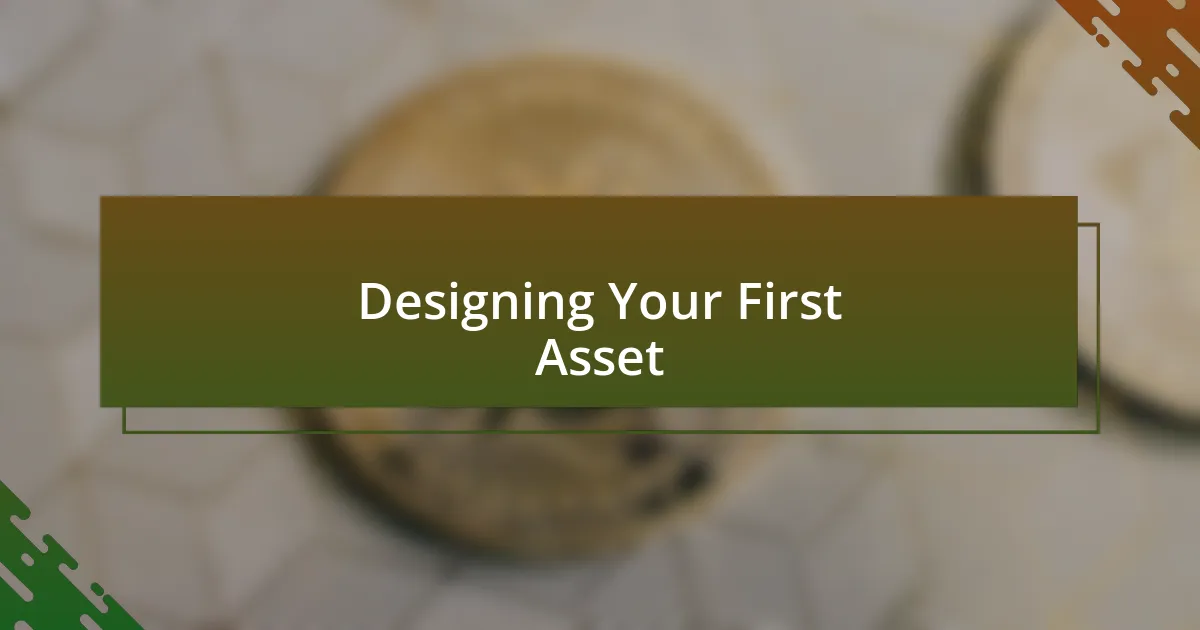
Designing Your First Asset
When I began designing my first game asset, I experienced a mix of excitement and anxiety. I vividly remember sketching my initial ideas on paper, watching the shapes come to life with each stroke. This process was an emotional journey for me; the act of transforming a simple idea into something tangible fueled my creativity and made it all feel real.
Designing an asset involves several key steps:
- Conceptualization: Start by brainstorming ideas, focusing on what fits your game’s theme.
- Sketching: Create rough sketches to visualize your asset. It allows exploration without commitment.
- Modeling: Use your chosen software to build the asset. Experimentation is encouraged during this phase.
- Texturing: Apply colors and materials that enhance the asset’s aesthetics and functionality.
- Feedback: Share your design with peers for constructive criticism that helps refine your work.
Reflecting on this process, I found each step to be a building block that shaped my skills. It was a learning experience that taught me the importance of patience and adaptability.
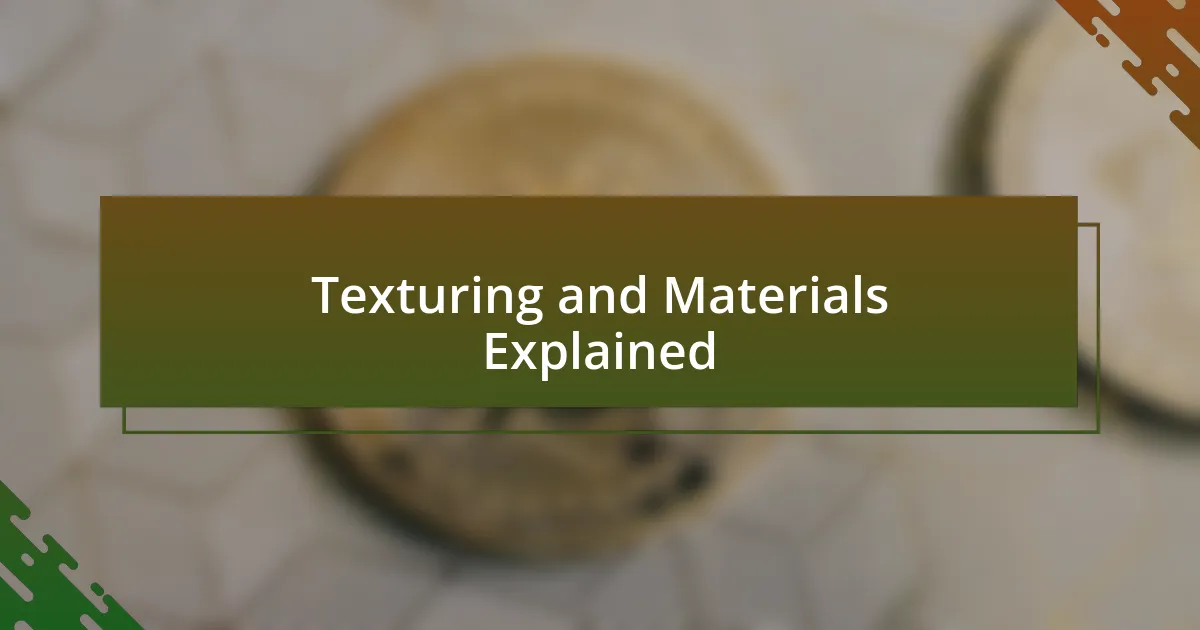
Texturing and Materials Explained
Texturing is one of those magical moments in asset creation where everything clicks into place. I still remember the first time I added textures to my model; it felt like I was breathing life into it. I had painstakingly crafted the shape, but when the right texture came into play, it transformed the look entirely. It made me wonder – how can something so simple evoke such emotion and realism?
When I worked on my first texture, I learned about UV mapping, which is essentially how to wrap a 2D image around a 3D model. It might sound complex at first, but once I grasped it, I realized how empowering it was. I found that a good texture can convey a story or hint at a character’s background. For example, adding scratches and dirt to a sword made it feel “used” and “real.” Wasn’t it fascinating how these small details could spark the imagination of anyone who viewed the asset?
Materials in game design go beyond just appearances; they influence how an object interacts with light and the environment. I remember experimenting with different shaders and settings, adjusting reflectivity and roughness, and watching how my asset’s personality changed. It was a real eye-opener to see how these choices impacted gameplay, making the environment not just a background, but a living element of the storytelling. Have you ever noticed how some virtual worlds feel more immersive because the materials used tell a deeper story? For me, that realization was a turning point in my understanding of game design.
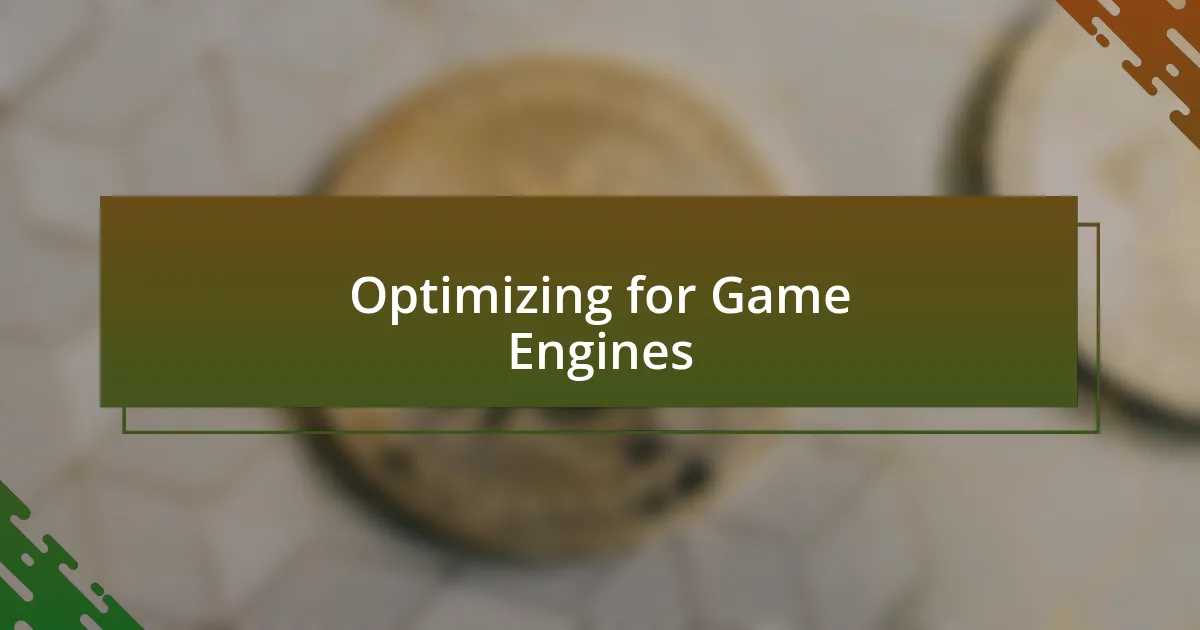
Optimizing for Game Engines
Optimizing for game engines is a crucial step in asset creation. When I first began working on my game assets, I found myself overwhelmed by the different engines available. Each one had its peculiarities, but it became clear that understanding a specific engine’s requirements could enhance my asset performance dramatically. For instance, reducing polygon counts while maintaining visual fidelity helped my models load faster and run smoother in the game.
One unforgettable moment was when I learned about level of detail (LOD). Initially, I didn’t see the point, but then I realized how important it is for improving performance. By creating multiple versions of a model with varying detail levels, I noticed significant frame rate improvements. It was rewarding to see my hard work translate into a smoother gaming experience. How surprising was it to discover that by adjusting detail based on distance, I could significantly impact gameplay?
Another key aspect I delved into was texture resolution. I remember my first experience where I was adamant about using the highest quality textures. It felt like a good decision at the time—until I noticed the frame drops during testing. Balancing quality and performance became my mantra. By staying mindful of texture sizes and using efficient image formats, I realized I could keep an asset visually appealing without sacrificing performance. Isn’t it fascinating how seemingly minor adjustments can make such a big difference in a game’s performance?

Importing into Game Environment
Importing assets into the game environment can be a nerve-wracking step. I remember when I first attempted to import my model into Unity; I felt a mix of excitement and anxiety. The moment I pressed that import button, my heart raced—I was finally bringing my creation to life! However, I quickly learned that matching the asset settings, like scale and orientation, was crucial. It took a few attempts for things to line up correctly, but it was an eye-opening experience that taught me the importance of preparation.
Once I successfully imported my asset, I was met with challenges that I hadn’t anticipated. My initial models suffered from clipping issues and unexpected texture stretching. It was frustrating seeing my hard work not display as intended. After some trial and error, I realized the value of using the game engine’s built-in tools for tweaking placements. Taking the time to familiarize myself with these options transformed my imported assets into polished pieces of the game’s puzzle.
Moreover, understanding the import settings significantly impacted how my assets were perceived in the game world. I remember when I discovered the importance of material settings—having the right shaders made a world of difference. It felt exhilarating to see how adjusting properties like reflections and lighting brought my models to life. Did you ever realize how vital these subtle tweaks are to the overall immersion? It’s these small adjustments that elevate a simple model to a beloved part of a player’s experience.

Testing and Iterating Your Asset
Testing your game asset can be a real turning point in the development process. When I first put my character model into the game, I was a bundle of nerves. To my surprise, the animations I had imagined didn’t translate well, resulting in some hilariously awkward movements. Have you ever watched a beloved character flop around like a rag doll? It made me realize just how crucial testing is to ensure that every detail aligns with the gameplay experience I wanted to provide.
As I began to iterate on my asset, I learned the importance of feedback. Initially, I thought my asset was perfect, but after sharing it with a few friends for testing, their insights were invaluable. They pointed out issues I hadn’t even considered, like how the color palette clashed with the game environment. After some revisions, I realized how vital collaborative input can be. Isn’t it amazing how fresh eyes can spot what we might overlook?
With each iteration, I started to see significant improvements. One day, after long hours tweaking and testing, I finally nailed a perfect run cycle for my character—something I had been struggling with for days. The satisfaction of seeing my asset move smoothly within the game was deeply rewarding. It reminded me that every bit of testing and feedback truly pays off in the end, enhancing not just the asset, but the entire game experience.







